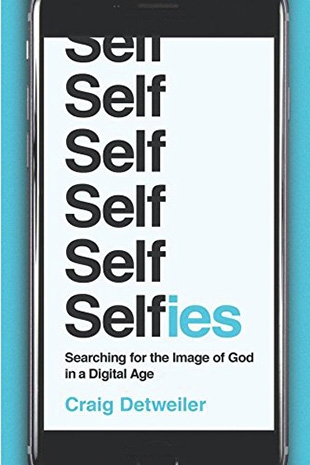In 2011, the word "selfie" had become so ubiquitous that the Oxford English dictionary proclaimed it "the word of the year." Art critic Jerry Saltz defined it as:
"A fast self-portrait, made with a smartphone's camera and immediately distributed and inscribed into a network, [a selfie] is an instant visual communication of where we are, what we're doing, who we think we are, and who we think is watching."
Craig Detweiler probes this popular, influential, and controversial form of communication in this thought-provoking, ambitious, and mesmerizing paperback. The author is a filmmaker, cultural commentator, and president of The Seattle School of Theology and Psychology. He uses the tools of psychology, sociology, art and literature, theology and Scripture to mine both the dangers and the delights of these self-portraits.
Why do we spend so much time taking pictures of ourselves?
"We want to be remembered, to have our presence noted. We post so many selfies for similar reasons, mostly having to do with this side of paradise. We want to be recognized, to be noticed, to feel loved and adored. So much of our online activity is about being seen, singled out, affirmed. We fuss and fret over our self-image because we know that it is how we will be introduced to large swaths of the world."
With a surge of energy, Detweiler covers core questions of identity — who we are as individuals and as persons created in the image of God. These subjects rise to the surface in chapters on the myth of Narcissus, the work of Renaissance painters, the contributions of writers to our yearning for self-expression, the importance of photographs, and the impact of the social media.
Even the quotations used to introduce chapters stretch our minds, such as:
- "I have always wanted to be me without making it difficult for you to be you."
— Howard Thurman - " Art is the representation not of the body but of the forces which created the body."
— Nikos Kazantzakis - "Man is a creature who makes pictures of himself, and then comes to resemble that picture."
— Iris Murdoch
In the last two chapters, Detweiler hits high stride, encouraging us to think about the present and the future of selfies. We can redefine ourselves by the hour with our devices; speed, ease, and audience are the traits that distinguish the selfie from the print photograph. But what kind of people take a lot of selfies? There seem to be three types: the self-publicists, the communicators, and the autobiographers. Each chapter of the book ends with "Questions to Consider/Discuss" and a "Selfie Challenge." Here he suggests you analyze your last five selfies and see which type you are. For the challenge, he suggests this:
"Think about how you envision yourself and who you'd like to be. Create a photo of that aspirational self — the self(ie) you're becoming. Print it and put it up where you will see it every day. Consider keeping that powerful image private – for your eyes only."
In the chapter "Augmented and Transfigured: The Selfie Tomorrow," Detweiler brings his theological training and personal faith into the discussion of selfies. In earlier eras, he recalls, images were the primary means of communicating God's story to mostly illiterate people. Still today the Orthodox tradition with its focus on Jesus as an icon of the invisible God affirms "Images are good. Images are signs of the divine." Orthodox Christian icons of Jesus engage the viewer: "As we stare into his eyes, we realize that the focus of Jesus is upon us, the viewer. . . . Jesus is entering our world, eager to enter into our thoughts and concerns."
Returning to his subject, Detweiler suggests a spiritual practice:
"Perhaps we can redeem the selfie by learning from this iconic encounter. When we turn the camera on ourselves, we are definitely the subject. We treat the camera as an object. But we do not consider it as having a life beyond. Could we peer into the camera with something more akin to the communion we experience with an icon? Can we envision the camera lens as looking into someone's eyes? Can we see Jesus staring at us through the lens? How does he view us? What does he see? And how might that change how we pose? If we understand that we are being seen with eyes of love, of encouragement, of compassion and support, then we have no need to act up or act out or really even to act at all. We can relax. And be honest. Be fully ourselves in moments of triumph or trail. We begin to love the camera as if it is a person who appreciates us. We respond to the camera with eyes of love and gratitude, something much more sublime than a smile."
Craig Detweiler's Selfies will help you see this ubiquitous form of social communication in new ways. As a bonus, you'll also see yourself — the subject of a selfie — as an ever changing image of God.
